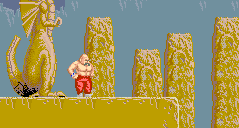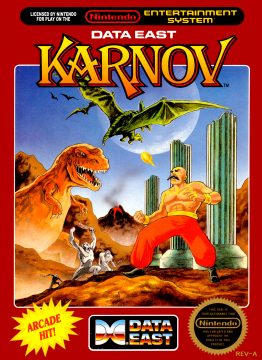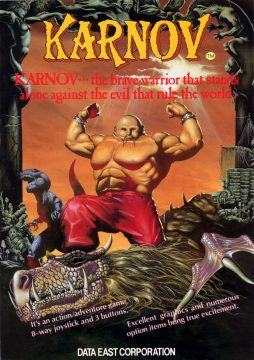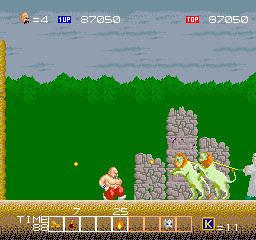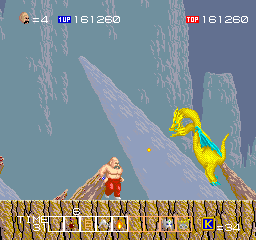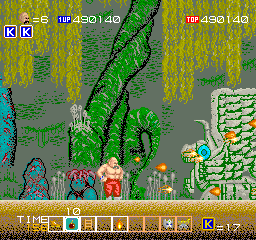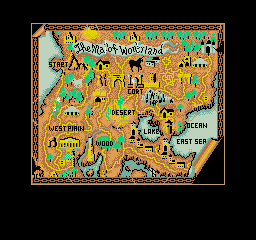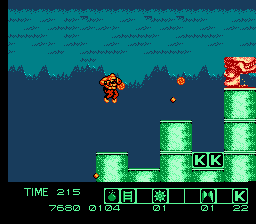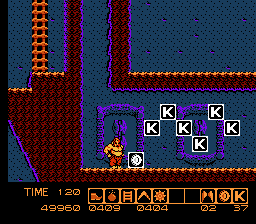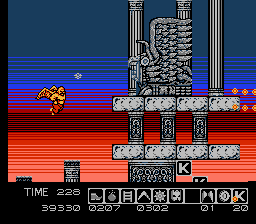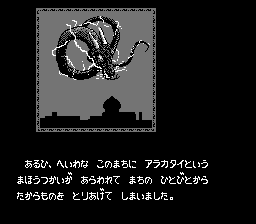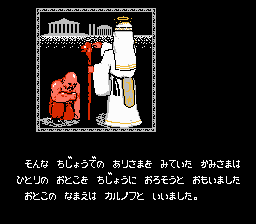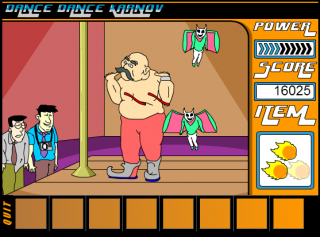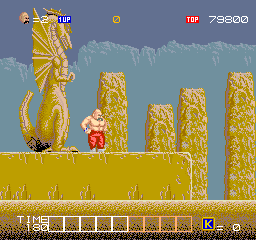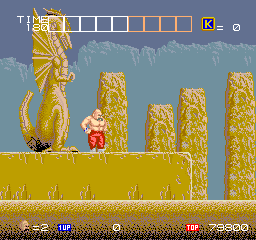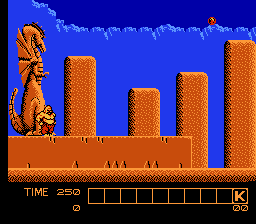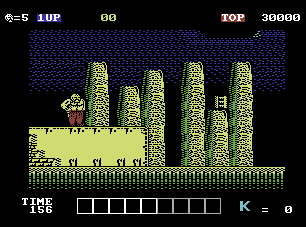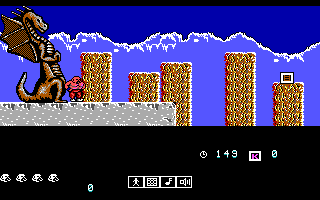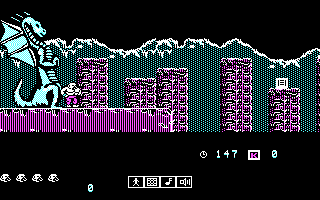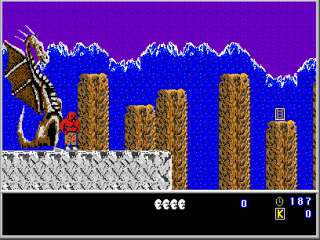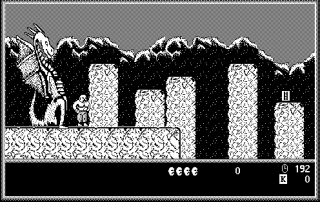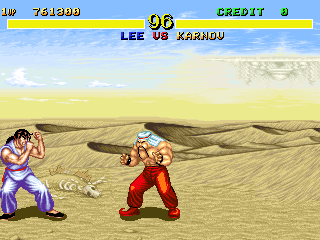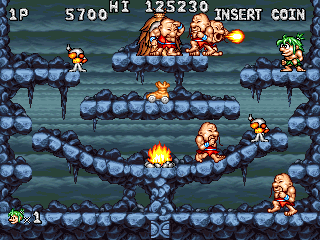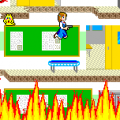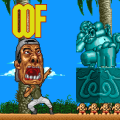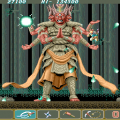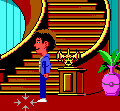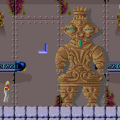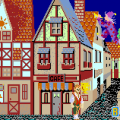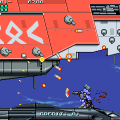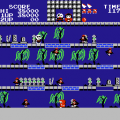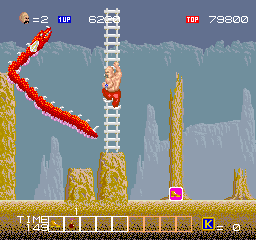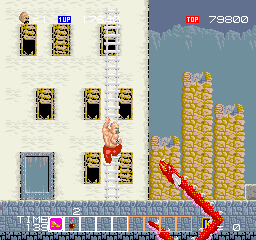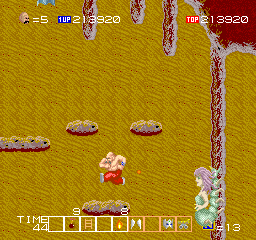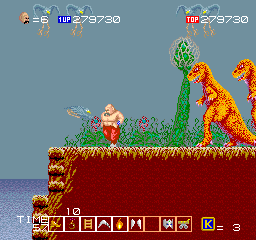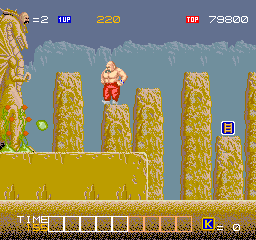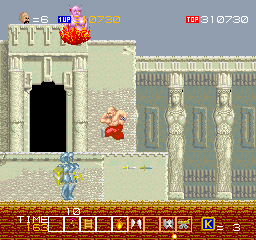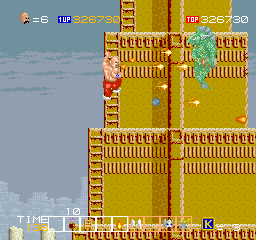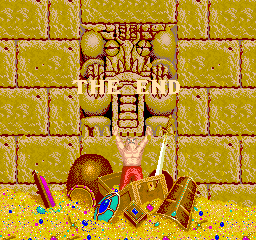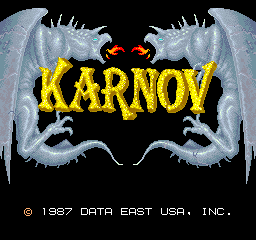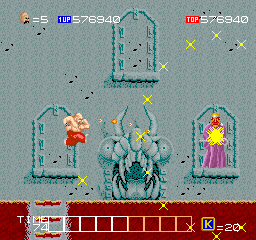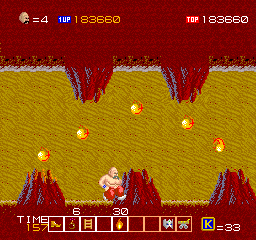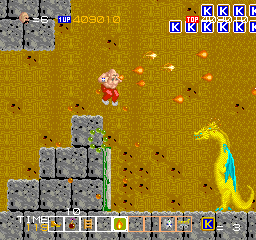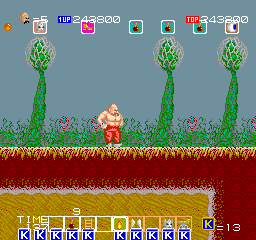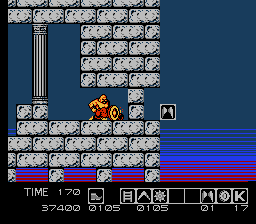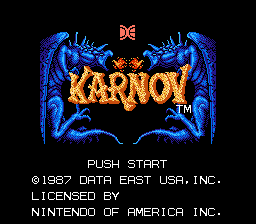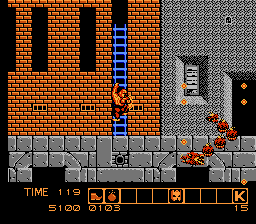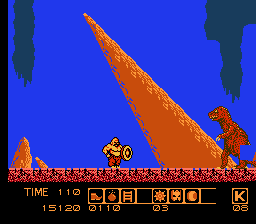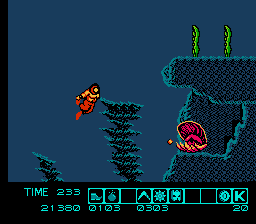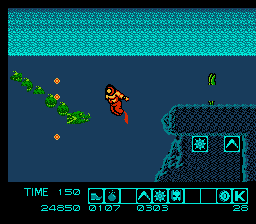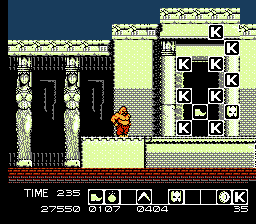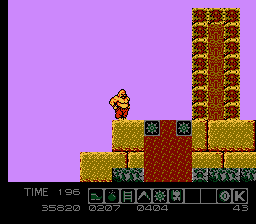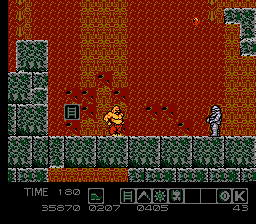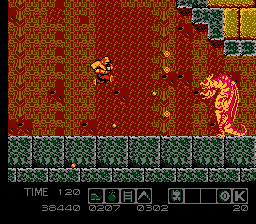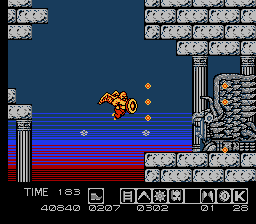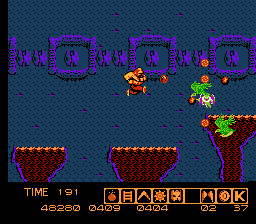Karnov, released to arcades in 1987, puts players in the shoes of the titular Russian fire-breathing strongman as he conquers nine levels to collect torn pieces of a map leading to a legendary treasure. According to an interview with Data East staff, he was based on a unnamed manager who worked for the company at the time. This was done without his knowledge, and after the resemblance was made clear, he was reportedly furious.
Despite looking like a side-scrolling platformer, Karnov is more akin to a run-and-gun shooter. Little emphasis is put on making jumps in favor of blasting away the waves of enemies that swarm the player. To make things easier, power-ups are scattered throughout the levels. These include “Super Fireballs” which allow Karnov to shoot an additional fireball with every blast (up to three maximum), and collectible “K Marks” that grant an extra life upon gathering fifty. The most interesting of all are the “Options”: various items that are placed in an inventory bar once acquired. Some Options can be activated at the player’s leisure, but more specialized items can only be triggered at specific points. For example, the “Super Flame”, singular flame shots that do greater damage and pierce weaker enemies (not to be confused with the Super Fireballs), can be activated whenever, but the “Swimming Mask”, which allows Karnov to swim faster, can only be activated underwater.
This all seems fine on paper, but the execution is spotty. Right out of the gate, the biggest issue lies in the enemy design, which hinges on overwhelming the player with sheer numbers and projectiles. This is exacerbated by the fact that the screen is cramped, giving the player little room to work with, and that Karnov himself is too big and slow to sufficiently dodge everything. Often the best, albeit most tedious tactic is to plod forward till enemies spawn, then retreating back to have enough space to eliminate them. Using Options judiciously and maintaining fully upgraded fire blasts can help mitigate these annoyances. However, being hit by a projectile or touching an enemy even once will immediately throw players back to the previous checkpoint barring any used Options, and at the base firepower level. This can turn checkpoints into traps, especially when they place players directly before difficult sections without any power-ups in sight. If you get a Game Over, you lose your Options. This can ruin the game for anyone who dies in a troublesome spot.
The Options themselves are hit and miss too. The “Boots”, which double Karnov’s speed and jumping prowess, and the “Boomerang”, that can take out bosses in a single throw, are absolute godsends. The retractable “Ladder” is another simple, yet novel feature, allowing Karnov to find collectibles hidden off-screen, or jump to previously unreachable ledges. Others, such as the “Bombs” and the rideable “Trolley”, are underutilized; the latter in particular can only be used once in a single level throughout the entire game! Another issue lies in having to tap the joystick left or right to flip through the inventory bar. It becomes especially awkward when trying to quickly activate an item in a bind.
To mix up the level designs, nearly every area offers branching paths with differing enemy patterns and collectibles. Sadly, more often than not these segments are much too short, lessening the incentive to experience one over the other. Worse still, every boss (excluding the final one) is reused repeatedly; this even happens multiple times within the very same level. The T-Rex, proudly displayed on the marquee and arcade flyer, is an intimidating sight the first time you face it, but it loses its bite by the sixth time you run into one.
Aside from a few forgettable short tunes and jingles, there’s only one main melody that plays throughout the game. Thankfully, it’s a unique and catchy song. Nevertheless, a few additional tracks would have better helped differentiate levels from one another. Similarly, regardless of its exotic Asian / Mesopotamian theme, the graphics fail to stand out thanks to little variance and a dull color palette.
Karnov went through a handful of changes when it was brought to the West. The original Japanese version placed the inventory bar and K Mark tally at the top of the screen, whereas the life count, points, and high score were on the bottom. The overseas version flips this, as the bar had a habit of obscuring collectibles in the sky. Also, originally Karnov’s firepower level would be reset after using the boomerang or Super Flame Options. This made utilizing these power-ups a precarious sacrifice. The overseas edition, however, allows players to activate them without fear of being crippled afterwards.
Other changes, such as the tweaked collectible placement, are hardly noteworthy, but a few are much less favorable. Even more enemies have been crammed into each level, only serving to make them more tiresome than fun. Granted, some of these enemies are entirely new, but they end up being nuisances rather than neat additions. One example is a flying dragon who will randomly spawn whenever players deploy the Ladder. Even worse are the seeds that fall from the sky and immediately transform into projectile spraying plants, should Karnov ever stay in the same screen space for over 10 seconds. These enemies cruelly punish players for exploring levels to find all of their secrets, hampering one of the better aspects of the game.
Karnov received a number of home computer ports of varying quality. The more popular conversions were for the ZX Spectrum, Commodore 64, and Amstrad CPC from Mr. Micro Ltd. Given the hardware constraints, they are fairly faithful to the overseas edition of the arcade game, though the soundtrack is missing, the levels have been somewhat simplified, and the enemies and bosses have been toned down. This turns the bosses into cakewalks, so long as players are packing enough firepower. The ports are plagued with slowdown, however, and Karnov controls even worse than before.
The ZX Spectrum version serves as the basis for the others, and has the sharpest, most colorful graphics overall. In contrast, the Commodore 64 version is an utter abomination. It looks atrocious, suffers from unresponsive controls, and runs slower than molasses. The Amstrad version stretches out the playfield, adds an original credits song, and has the least slowdown compared to the other two. It lacks the ZX Spectrum’s color variety, but this is by far the best home computer port overall.
There was also a DOS port handled by Quicksilver Software, Inc. This conversion is closer to its overseas arcade counterpart, with more accurate levels, vibrant graphics, and faithful renditions of the original soundtrack. However, a large black bar covers just over a third of the bottom screen, giving the game a squashed appearance. This port runs quite faster than any other iteration of Karnov, and the screen has trouble keeping up. Karnov’s clumsiness is made all the more frustrating when enemies rush him in every direction quicker than players can possibly react. Throw in wonky collision detection, an oversized player hitbox, an awkward, toggle-based movement system (players must press a key to make Karnov move or crouch, and then press another to stop), and you have a port that is best left forgotten.
Finally, the DOS version received a conversion to the Macintosh via Technology Works, Inc. It excises the horrid toggle controls and runs the game at the smoothest pace out of all the home computer ports. It even adds a practice mode that allows players to tackle any level (excluding the final one) with every single item at their disposal and infinite lives. Better yet, players tab through their Options via a designated button rather than awkwardly tiptoeing left or right. The graphics are not quite as sharp or colorful as the EGA DOS version, but they’re still superior to anything from Micro Ltd. There are still issues, though.
First of all, it lacks any music or sound effects whatsoever. Second, Karnov jumps as if he’s on the moon, making his still- oversized hitbox easy prey for projectiles while aerial. Worst of all, enemies frequently spawn directly in front of the player before there is any time to react. This results in tons of infuriatingly cheap deaths, and cripples what could have been Karnov’s best computer port.
Sakata SAS’ NES port remains fondly remembered to this day, as it mends many of the frustrations that plagued the original. For instance, despite being based on the overseas arcade game, the enemies and projectiles have been dialed down to more manageable levels. The seeds of death are nowhere in sight, and the flying dragon has been cut down in size. In fact, everything in the game has been shrunken down, freeing up a great deal of screen space and allowing for improved maneuverability. Even better, Karnov can now take an extra hit before dying, which turns him blue until he finds a Super Fireball, which restores his health. Combine this with the generous spread of power-ups, as well as the ability to retain Options after a Game Over, and the NES Karnov is a huge improvement.
Additionally, new tweaks and features have been thrown into the mix. Players can now pause the game at any time, flip through the inventory bar at their leisure, and activate one Option immediately upon un-pausing. The lackluster Trolley and Super Flame have been replaced with the “Shield”, which can block up to five projectiles before being destroyed, and the “Clapper”, a smart bomb that destroys all enemies (excluding bosses) and projectiles on screen. These are both phenomenal inclusions that give Karnov a defensive edge in tight situations. Likewise, stages 4 and 8, previously a rushed jaunt through a small volcano and a mundane slog through a jungle, respectively, have been entirely redone. Both now focus instead on the utilization of particular Options, making for the most interesting levels of the entire game. It’s disappointing that more stages weren’t revised or at least expanded in this fashion.
As to be expected, the levels had to be cut down. It’s a faithful translation for the most part, but a handful of cool details, like the ability to knock the tree over to make a bridge in level 3, have been removed. Also, as is customary for every conversion of Karnov, the programming leaves something to be desired. The screen has difficulties keeping pace with the player, either limiting the view ahead or outright slowing the game down until the program is able to catch up. Other annoyances include enemies that respawn when scrolled off-screen.
Like the original arcade game, there are a few differences between the Famicom and NES versions. The Famicom’s story, told via in-game cutscenes, tells of an ancient evil dragon named Alakatai and his demonic entourage terrorizing the peaceful land of Creamina, and ransacking all of its treasures. Observing the chaos below, the Abrahamic God (complete with a halo over His head and a crescent moon and star on His back) sends Karnov, a once evil man now in His servitude, to redeem himself by saving the people. The story continues throughout, as God encourages the player and doles out tips for each level. Unsurprisingly, this was all cut out in accordance with Nintendo of America’s religious censorship. Therefore, the NES’ story, exclusively contained within the manual, features the dragon, now named Ryu, specifically stealing the “Treasure of Babylon”. The only hope left? Jinborov Karnovski, a “one-time circus strongman with a unique talent for shooting fireballs!” Furthermore, whereas the NES game allows infinite continues, the FC game only offers two. FC players can continue after inputting a password, and the ending changes for the worse each time it is used. In comparison, the NES version just concludes on a black screen with a brief congratulatory message.
Karnov is a unique title with neat ideas marred by a rough execution. It’s a shame that it never got a fleshed out sequel – who knows how far the shirtless Russian fire-spewing agent of God could’ve gone?
Still, Karnov hasn’t been completely ignored – he’s made many cameos over the years, and functions as the final boss in the Fighter’s History line of fighting games. He hasn’t been forgotten by the fans, either. In 2005, a group of amateur film students in Pittsburgh made a live action Karnov fan movie, which also includes cameos from tons of other NES games. In 2001, the comedy website Something Awful also developed a Flash game called Dance Dance Karnov, a rhythm gane parody of Dance Dance Revolution. It includes remixes of themes from the NES game, along with some familiar enemies referred to as “Evil Yoda in a nest” and “Green fish guy with bag and hand down his pants”. It’s also incredibly goofy – the exuberant announcer speaks in broken Engrish, and if you perform well enough, Karnov will either wear an Afro or put on stripper-esque nipple tassels.
Screenshot Comparisons
